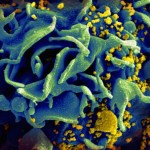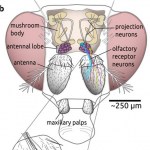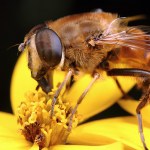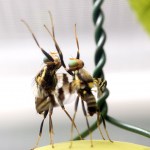flies
A special thank you to reader Dr. Barbara Goodman, Professor of Physiology at Sanford School of Medicine of the University of South Dakota who sent me a story from The Scientist about sleep in animals complete with footage of a dolphin that was seen apparently "sleeping" (video posted on YouTube):
Why do animals sleep? This is a question with many potential answers. It is known that birds and mammals experience slow-wave and rapid eye movement (REM) sleep patterns. During the first pattern, slow waves with high amplitudes can be seen if measuring electrical…
Scientists use a 'gene gun' to insert a gene from a flowering plant called rockcress into the cells of wheat seeds. The genetically modified wheat became more resistant to a fungus called take-all, which in real life can cause "a 40-60% reduction in wheat yields."
T-cells from six HIV+ patients were removed from their bodies, treated with a zinc-finger nuclease designed to snip a gene out of the cell's DNA, and put back in the patients. Removal of the gene mimics a naturally occurring mutation which confers resistance to the HIV virus. But only 25% of the treated cells showed…
New research published in Science Reports by Strauch et al., shows that fruit flies can tell the difference between cancerous and healthy cells. The researchers recorded calcium patterns indicative of neuronal activity that was stimulated in response to various odors emitted by healthy and cancerous cells. Because cells with cancer differ metabolically from healthy cells, they emit different volatile compounds that can be detected by olfactory receptor neurons on the antennae of fruit flies. When exposed to breast cancer cells or healthy cells, the flies exhibited different patterns in…
Eristalis, the drone fly
Urbana, Illinois
Easily mistaken for a bee, Eristalis is in fact a clever mimic capable of luring many an unsuspecting observer into the land of amusing taxonomy fail.
But the structure of the antennae, the broad attachment of the abdomen to the thorax, and the presence of only a single pair of wings mark it as a fly.
I took this photo in bright sunlight, although it doesn't look that way from the black backdrop. This dramatic lighting effect is achieved by using such a small aperture (f/13) and a fast shutter speed (1/250 sec) that almost no ambient light reaches…
The trailer for Shaun of the Dead.
Not all zombies are created equal. The most popular zombie archetype is a shambling, brain-eating member of the recently deceased, but, in recent films from 28 Days Later to Zombieland, the definition of what a zombie is or isn't has become more complicated. Does a zombie have to be a cannibal corpse, or can a zombie be someone infected with a virus which turns them into a blood-crazed, fast-running monster?
For my own part, I have always preferred the classic George Romero zombies from the original Dawn of the Dead and Day of the Dead films (as well as…
Eastern Treehole Mosquito
My commercial gallery now has flies!
Diptera photographs at alexanderwild.com
I feel sort of embarassed at how few fly images I have, considering the importance of the group. That's something I'll try to remedy as we get into this summer's photography season.
Two male Rhagoletis walnut flies joust on an artificial walnut in a lab cage at the University of Arizona. What's an artificial walnut? It's a painted ping pong ball. As long as the ball is the right color and shape, the flies apparently don't mind.
Biologist Jeremy Davis uses these flies to study the interaction between fruit quality and fly behavioral ecology.
Of course, for the flies it's all about access to females.
Technical details.
top photo: Lens: Canon MP-E 65mm 1-5x macro lens
Body: Canon EOS 20D dSLR
Flash: Canon 550EX flash, indirect
Settings: ISO 200, f/11, 1/200 sec
middle…
We get a lot of information from watching other people. We read reviews, we follow links to recommended websites and we listen when our friends vouch for strangers. The opinions of strangers may even be a better guide to the things that make us happy than our own predictions. But humans aren't the only species to make decisions based on information gleaned from our peers - even animals as supposedly simple as flies can do the same.
Frederic Mery from LEGS (the Laboratory of Evolution, Genomes and Speciation) studied the fly Drosophila melanogaster and found that females have a tendency to…
A long-tongued horse fly takes a sip of nectar in Arizona's Chiricahua mountains.
100% crop of the same image.
photo details: Canon 65mm MP-E 1-5x macro lens on a Canon EOS 20D
ISO 100, f/13, 1/250 sec, flash diffused through tracing paper
Rhagoletis fruit flies mating, Arizona
photo details: Canon MP-E 65mm 1-5x macro lens on a Canon EOS 20D
ISO 200, f/11, 1/200 sec, backlit by handheld strobe.
Nosodendron californicum - Wounded Tree Beetle
California, USA
From the Department of Really Obscure Insects, here's a beetle that few non-specialists will recognize. Nosodendron inhabits the rotting tissue of long-festering tree wounds. These beetles are not rare so much as specialized to an environment where few entomologists think to look.  If you can spot the telltale stains of an old wound on the trunks of large trees, you should be able to find Nosodendron. They feed on the microbes- the yeast and bacteria- that grow in the sap leaking from the phloem.
There…
Can't devote much to blogging at the moment, but since we're feeling sorry for the dipterists this week here's a fly for you to look at:
Gall Midge, Cecidomyiidae - California
Maybe one of you fly folks could explain in the comments why Cecidomyiids are so cool. Aside from looking like little fairies, that is.
photo details: Canon MP-E 65mm 1-5x macro lens on a Canon D60
ISO 100, f/13, 1/200 sec, flash diffused through tracing paper
Dipterist Keith Bayless exposes a pernicious case of media bias:
Six new families of Diptera were described from newly discovered species in the last 6 years! None of these flies received the press coverage given to Martialis. There are a variety of explanations for this, including that
1) The fly descriptions were published in lower profile journals than PNAS
2) Many of the the new fly families evolved more recently than the first ant in the Martialis lineage
3) The level of public and scientific interest in ants inclines them to be better covered or
4) People who study ants are better at…
I can't imagine a more unpleasant way to go. This poor oleander aphid (Aphis nerii) has its innards sucked out by a hoverfly larva.
photo details: Canon MP-E 65mm 1-5x macro lens on a Canon 20D
f/13, 1/250 sec, ISO 100
MT-24EX flash diffused through tracing paper
levels adjusted in Photoshop.
Igor Siwanowicz, who shot this series of a fly breaking free of its puparium, is among the finest studio photographers of insects. He's got a particularly sharp eye for lighting and his compositions are often playful. Go visit Igor's portfolio.
Mallophorina sp. - Robber Fly
Chiricahua Mountains, Arizona
details: Canon MP-E 65mm 1-5x macro lens on a Canon D60
f/13, 1/200 sec, ISO 100
Flash diffused through tracing paper
levels adjusted in Photoshop



